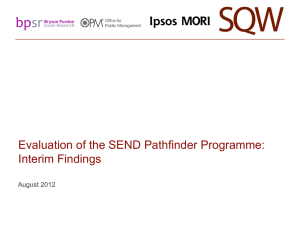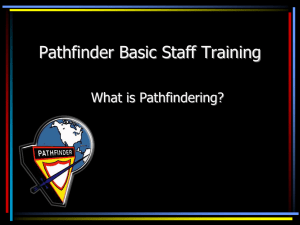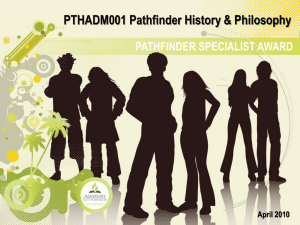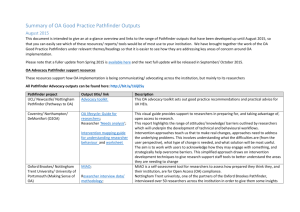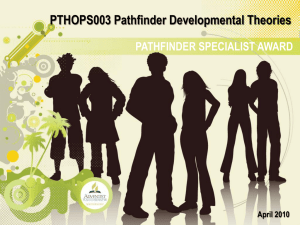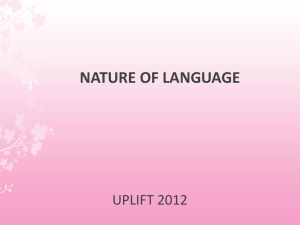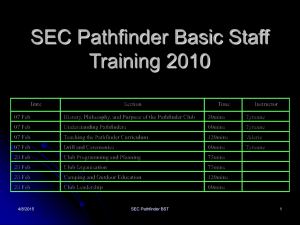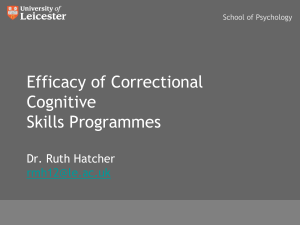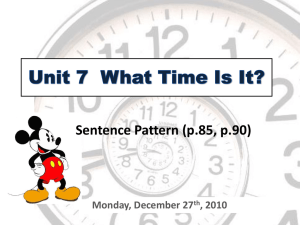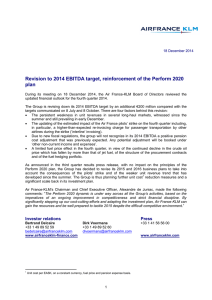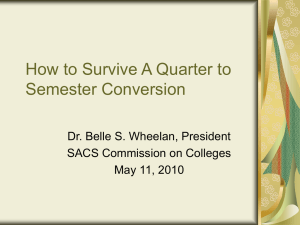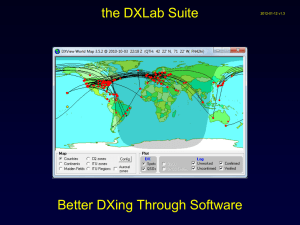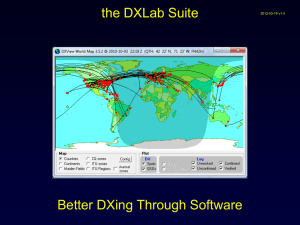Evaluation of the SEND pathfinder programme: early findings
advertisement
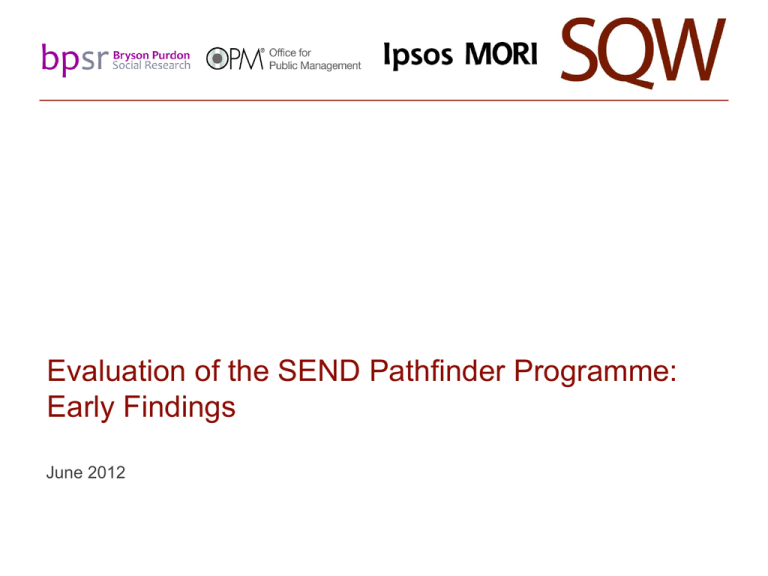
Evaluation of the SEND Pathfinder Programme: Early Findings June 2012 1 Outline The findings reported Are based on the first monitoring returns provided by all Pathfinder sites Are sites own perceptions of progress = Development not yet begun = Early stage development Movement left to right within the diagrams indicates increasing progress = Partial development = Full implementation = Already in place prior to the Pathfinder Cover the period to the end of March 2012 Are based around the Common Delivery Framework (CDF), which sets out a series of themes and elements which it was anticipated each Pathfinder would need to address Will be updated quarterly based on future monitoring submissions 2 Pathfinder progress setting up governance structures by end of March 2012 Substantial progress setting up governance structures A clear set Developme of Project nt of a objectives Board/Gove project have been rnance plan? agreed Structure Three quarters of areas (22) had their board or governance structure fully in place Two thirds (19) had agreed a clear set of Pathfinder objectives Quarter 4 Quarter 3 Quarter 4 Quarter 3 Quarter 4 Quarter 3 0 5 10 15 20 25 Number of Pathfinder areas Development not yet begun Early stage development Partial development Full implementation Already in place prior to becoming a Pathfinder 3 Stakeholder engagement There is a group of stakeholders that are common to almost all sites …but also some less represented than might expect – but may reflect local focus / circumstances Good progress on staffing… but more mixed on other developments Almost all areas had a designated Pathfinder lead in place, and three quarters had a nominated project manager Wider restructuring had caused issues in some areas Leads and Project Managers most often from education or a multiagency background Most areas reported that they had at least partially developed commitment from education (28), social care (25) and health (25) to share resources signalling some collective responsibility Far fewer had secured resource for the resultant service provision Most of the Pathfinder areas had started to consider the development of their approaches to change management, market development and the local … but many still perceived themselves to be in the early stages of developing these elements 4 5 Parent-carer and VCS involvement in the development of the Pathfinder Engagement of a representatio n of children Engagement Engagement and young of parent of the VCS in people in the carers in the the development development development of the of the of the Pathfinder Pathfinder Pathfinder Pathfinder areas had made good progress in terms of engaging the VCS and parent/carers in the development of the Pathfinder Although the majority of areas were still in the early stages (or had not yet begun) engaging children and young people in this development Quarter 4 Quarter 3 Quarter 4 Quarter 3 Quarter 4 Quarter 3 0 5 10 15 20 25 Number of Pathfinder areas Development not yet begun Early stage development Partial development Full implementation Already in place prior to becoming a Pathfinder 6 Overall it is a mixed picture across the areas 19 judged at least a third of the 16 progress measures to be fully in place 13 were still in the early stages of developing (or had not yet begun) a third of their progress measures Progress engaging and involving families and young people to participate in the Pathfinder Most had begun to consider raising awareness with families and young people … but few had done so As a result the numbers recruited to the end of March were very small By early June the number recruited had risen to 129 – but heavily dependent on one site The vast majority of those recruited were already in receipt of SEN support … and 80% receiving specialist health support 7 8 Progress setting up the Pathfinder infrastructure By the end of March 2012 all Pathfinder areas had begun to develop their assessment and single plan pathway Around half of the areas had reached ‘partial development’ of the assessment pathway and were considering A set of assessments (by different agencies) being brought together – 12 of 14 areas Single assessment episode supplemented by ad hoc specialist assessments – 8 of 14 areas The most common planning approaches being considered by the 14 areas were Single planning events The use of a planning coordinator to create the plan with the family and liaise with professionals from relevant agencies to obtain their input Relatively few had progressed personal budgets, information sharing or risk management 9 Key conclusions and implications CONCLUSIONS All areas had set up a Project Board/Governance structure, which included engagement from the following stakeholders • IMPLICATIONS • How to engage the stakeholders that have proven to be more difficult to engage or that may not be linked to the immediate target group, but will play a part in the development of a 0-25 yrs approach • How to ensure accountability of the resource that is required for the service packages The majority of areas had a • The extent to which operational staff had been actively engaged in designated Lead and a Project the development of the Pathfinders was unclear • Change management of operational staff will be crucial, and needs Manager in post progressed to fit with family recruitment Around half of the areas reporting they had at least reached the partial development stage of their assessment and single plan pathway • How areas can scale up their developing approach for the whole 025 yrs and for existing and new cases post the Pathfinder • To date most recruitment has been of families already in receipt of services • There is less progress on personal budgets and information sharing 10 Contact Graham Thom Meera Prabhakar Director Senior Consultant SQW SQW t. 07766 916897 t. 07715 071574 e. gthom@sqw.co.uk e. mprabhakar@sqw.co.uk w. www.sqw.co.uk w. www.sqw.co.uk

